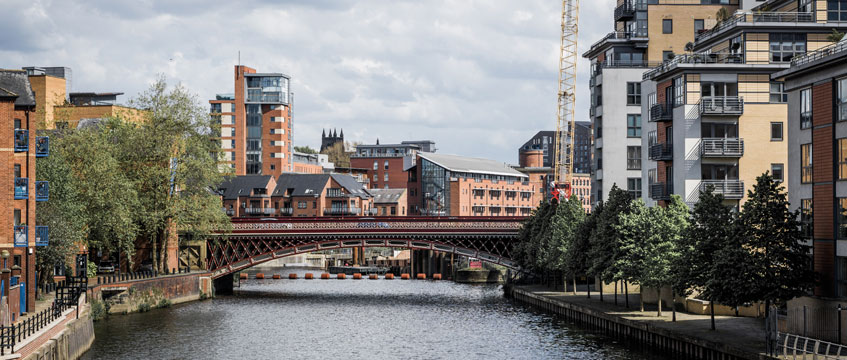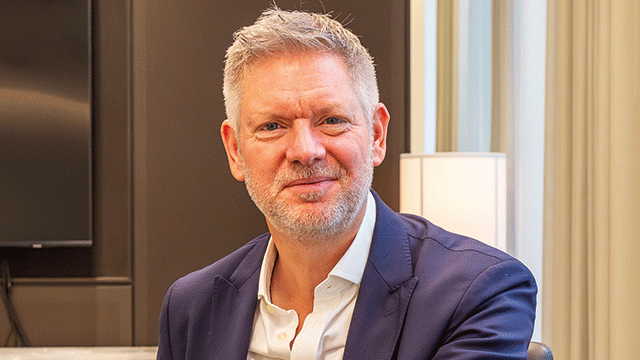Pounds and patience as Leeds transforms
At Aire Park, a big regeneration project in Leeds, a sculpture has been unveiled that city leaders hope will let the city look forward with optimism at the same time as reckoning with its past.
Yinka Shonibare’s Hibiscus Rising honours David Oluwale, a British Nigerian and Leeds resident who drowned in the River Aire in 1969 after being harassed by members of the city’s police force. The team behind the artwork want it to become “a story of reconciliation, healing and renewal for the city”.
“This sculpture is about looking positively to the future, how we’re repairing our past and how we’re bridging communities,” says Angela Barnicle, the city council’s chief officer for asset management and regeneration. “And that’s what we all do around this table, isn’t it? We’re bridging communities every day.”
At Aire Park, a big regeneration project in Leeds, a sculpture has been unveiled that city leaders hope will let the city look forward with optimism at the same time as reckoning with its past.
Yinka Shonibare’s Hibiscus Rising honours David Oluwale, a British Nigerian and Leeds resident who drowned in the River Aire in 1969 after being harassed by members of the city’s police force. The team behind the artwork want it to become “a story of reconciliation, healing and renewal for the city”.
“This sculpture is about looking positively to the future, how we’re repairing our past and how we’re bridging communities,” says Angela Barnicle, the city council’s chief officer for asset management and regeneration. “And that’s what we all do around this table, isn’t it? We’re bridging communities every day.”
The table in question was at the Crafthouse restaurant in the city centre, where shortly after Hibiscus Rising was unveiled, EG held its final Cities roundtable of 2023. With the support of Savills and Shoosmiths, leaders from the public and private sectors came together over dinner to discuss the changing economic make-up of the city, the opportunities for real estate as new industries emerge, the promise of a long-awaited mass transit system and, overarching everything, how the various stakeholders in the built environment can bridge the city’s professional and personal communities.
[caption id="attachment_1214256" align="aligncenter" width="1134"] Yinka Shonibare’s Hibiscus Rising, which honours Leeds resident David Oluwale who died in 1969[/caption]
“This is a really great time to be in Yorkshire and in Leeds, and I say that against a really difficult backdrop,” Barnicle says. “We’ve got a lot of ‘iceberg’ activity happening, where the groundwork that’s been done over the past 10 years is really starting to come through.”
Kellie Hatton, Sheffield-based real estate partner at Shoosmiths, knows that other regional towns and cities can look to Leeds for inspiration.
“I’ve always been very impressed by Leeds and sometimes I think that Sheffield needs to get the boost that Leeds has generated,” she says, adding that other cities could do worse than look to “the scale, the density of culture, food and beverage, the night-time economy… there’s a scale in Leeds.”
Knotty projects
Aire Park is being overseen by Dutch investor-developer Vastint. Once complete, the scheme, on the site of the old Tetley Brewery, will have 1,400 homes and 1m sq ft of commercial space. For Michael Cronin, Vastint’s head of portfolio for the UK, such a project exemplifies the kind of long-term vision that a developer such as the Dutch group can bring to regional cities.
“We like chunky, mixed-use regen projects,” Cronin says. “What we managed to convince [Tetley owner Carlsberg of] was that we had the ability and the patience and the determination to see that project through. These are long-term, complex, knotty projects. It’s not just ‘build a building, let it, move on and do something else’. It’s curating that park, the ground-floor retail and everything else that goes with it. We’re fortunate that we have that ability to take a long-term decision and have the vision. We’ll hold it and it will be a long-term income stream for us.”
The notion of taking a long-term outlook without forgetting the city’s past came up often over the near-two-hour discussion. As Leeds’ economy diversifies, new real estate needs are keeping investors and developers on their collective toes. Simon Lister, head of the Leeds office for Savills, sees this as “an exciting time” for the city and region’s life sciences industry, for example. He has helped institutional investors back schemes that have shown there is plenty of opportunity outside of the traditional Golden Triangle of Oxford, Cambridge and London.
Jennifer Wilson, director of campus innovation at the University of Leeds, moved to Leeds in October from London, where she had worked on Imperial College’s White City Innovation District. She describes Leeds as having “all the ingredients to form a fantastic innovation cluster”.
“London does a very good job of the PR story of talking about how closely interlinked the universities are with the teaching facilities, with the labs – but in truth, they’re quite a long way apart,” she says. “There’s a lot of constraints, there’s not the space. I came to Leeds and thought, ‘the hospital is right next door to the major universities and in 10 minutes you can be out on the industrial parks around the M1 – perfect locations for delivering GMP [good manufacturing practice] facilities’. It’s right here, plus the talent base, plus what we would describe as a workable developer community.”
That prospect will pique the interest of investors that would once have wanted more traditional assets, reckons Simon McCabe, chief executive of Scarborough Group.
“The institutions that are the typical ‘build an office building, lease an office building’ are at this moment sitting on their hands a bit,” McCabe says. “Where some of them are adapting quite well is buying into some of these new industries such as life sciences or advanced technology, where they’re prepared for their capital to be a bit more patient. They’re not in it for the short term. They build an ecosystem, they build a neighbourhood, they build a community of people, businesses that all want to work together.”
Communities such as Nexus, a campus at the University of Leeds that director Gareth Scargill describes as the link between academia and industry (the site is also a filming location for shows including Netflix crime thriller Bodies). But these too face challenges, Scargill notes. “We have some members now that have got to that critical mass at which we can’t accommodate them any further within our footprint,” he says. “However, they’re not in a position to take a floorplate or half a floorplate so where do they go?”
It’s an issue for larger tenants too, says Katie McManus, development manager at HBD. “Our role [in building an innovation ecosystem] is providing the platform for different businesses and collaborators to come together,” she says. “We need to find the land for that. That’s the issue. If, for example, we had an enquiry from a major life sciences company saying, ‘we want 150,000 sq ft in the city centre, can you deliver it for us?’ Actually finding that site and having that programme and certainty of delivery – for us, as a developer, at the moment we don’t.”
Lessons of the past
On the residential side of the market, too, is scope for greater growth and bigger ambitions, says Jean-Marc Vandevivere, chief executive of build-to-rent developer and operator Platform_. The company has 4,000 units built, under construction or in the pipeline, with the eight-acre site on Sweet Street West in Leeds’ South Bank regeneration area its largest so far, at 1,350 homes.
Vandevivere’s numbers make clear the scale of the opportunity. Manchester has 36 BTR schemes with 12,000 homes across them, he says. Leeds, a city of a similar size, has six schemes with 2,000 homes. “We thought, can we help the city? Can we take advantage of its dynamism? And is there enough potential to build a substantial amount of residential in the city?” he says. “We thought there’s an opportunity to do something special.”
That opportunity will change and reshape the city centre, predicts Phil Gregory, a partner at Shoosmiths who came to Leeds to study and never left. City centre residential has typically been focused on “young professionals”, he says. Now there’s the chance to see whether the city can “evolve for families”.
A new mass transit system could – eventually – encourage that evolution. Ben Still, chief executive of the West Yorkshire Combined Authority, says the emerging plans for a mass transit system – which has been tried unsuccessfully in Leeds several times already – will transform a city that he describes as “the engine room for West Yorkshire”.
The city has “tried to learn the lessons of the past”, Still says. “The logic of it is based around where can we be sure that we can deliver. Past attempts have been based around where the business case is strongest, regardless of how easy that scheme would be to deliver,” he says. “We’re turning that around. The most important thing is to get something on the ground that we could then add to over future generations.”
There will be nerves that this project could go the same way as the northern section of the HS2 line. But Danny Collins, director in Savills’ economics team, says the potential is huge. The key now, he says, is “pushing ahead, [with] strong leadership from the public and private sector to get that in”. “Then,” he adds, “it’s about the ‘so what?’ for the surrounding area: how do we maximise the transport uplift from that?”
Get all these things right, Still says, and the city centre proves its resilience. “The post-Covid dynamics of how a city economy works have not fundamentally changed,” he says.
“We are not seeing a complete dispersal away from city centres. We are not seeing a massive desire from office workers to stay working from home. Patronage through Leeds station is higher than it was pre-pandemic. The city centre is back.”
The experts
Angela Barnicle, chief officer for asset management and regeneration, Leeds City Council
Danny Collins, director, economics team, Savills
Michael Cronin, portfolio director, Vastint
Phil Gregory, partner, Shoosmiths
Kellie Hatton, partner, Shoosmiths
Simon Lister, head of Leeds, Savills
Simon McCabe, chief executive, Scarborough Group
Katie McManus, development manager, HBD
Gareth Scargill, director, Nexus Leeds
Ben Still, chief executive, West Yorkshire Combined Authority
Jean-Marc Vandevivere, chief executive, Platform_
Jennifer Wilson, director of campus innovation, University of Leeds
In partnership with
To send feedback, e-mail tim.burke@eg.co.uk or tweet @_tim_burke or @EGPropertyNews
Image © Illiya Vjestica/Unsplash











